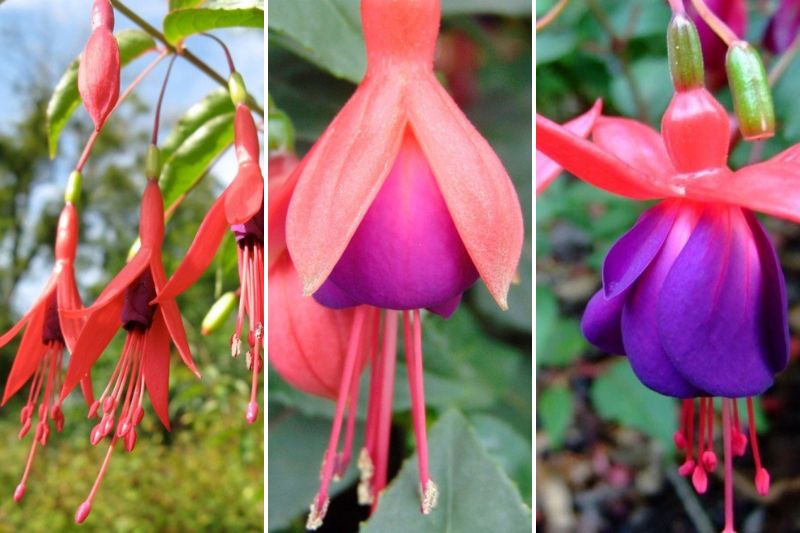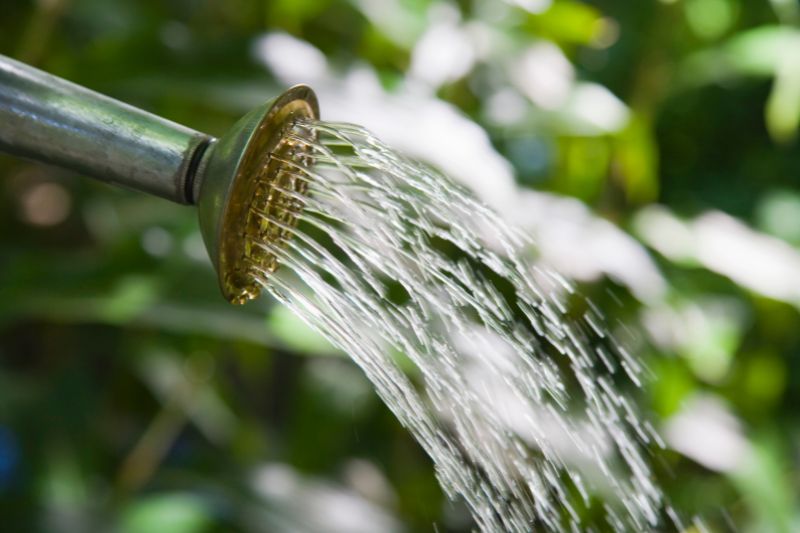Fuchsias brighten up shady garden areas with their trailing, colourful bell-shaped flowers throughout summer. These perennials can have various forms: bushy, trailing, spreading or standard. In the latter case, the fuchsia displays an upright, straight trunk topped with a rounded clump of leaves. It then becomes a true small standard bush, adding beautiful volume and a graphic touch to both garden and container displays.
This relatively simple technique to perform at home mainly requires patience to obtain a fine specimen. Follow our tutorial to learn how to train your fuchsia as a standard, along with our care advice.
Which varieties to choose for creating a standard fuchsia?
To achieve a standard fuchsia, prioritise upright, vigorous varieties with an erect habit. Ideally, they should reach at least 50 to 75 cm in height. Select them based on the final height you wish your standard bush to attain. Conversely, avoid spreading varieties, which are wider than tall, or climbing varieties whose branches must necessarily be supported.
Consider for example:
- The Magellan fuchsia (Fuchsia magellanica) 'Riccartonii' (1.20 metres tall with a 60 cm spread) or 'Gracilis' (1.50 metres tall with a 60 cm spread);
- The hybrid fuchsia 'Mrs Popple', with an upright habit reaching 1 metre in height and 70 cm in spread;
- The hybrid fuchsia 'Marjory Black', with an erect silhouette measuring 90 cm tall and 50 cm wide.
Choose a healthy young plant with a well-vertical central stem. It may come from a potted plant or a cutting.



When to train a fuchsia as a standard?
The ideal period to train a fuchsia as a standard is during the growing season, from late spring to late summer (from late May to early September).
The different steps for pruning and forming a standard fuchsia
Staking
To obtain a fine standard fuchsia, the first step involves staking the central stem, so it develops perfectly straight and vertical.
- Choose a stake taller than the final height of your stem.
- Gently insert it into your fuchsia's growing medium, about 5 to 10 cm from the base.
- Attach the main stem at several height levels using ties (approximately every 5 cm), so it remains stable but not too tight to allow sap to continue circulating.
- As growth progresses, add more ties to allow the stem to develop in height.
- Also adjust existing ties to prevent the stem from being constricted as it thickens.
Pruning
To train a bush as a standard, the second step involves regularly removing new shoots to allow sap to rise.
- Using secateurs (or by hand), cut all new lateral shoots once they reach about 10 cm in length. You can take this opportunity to make cuttings. To learn how, follow our tutorial "Propagating Fuchsias from Cuttings".
- Also remove any suckers emerging from the base.
- Allow leaves on the central trunk to develop to enable photosynthesis.
- Retain 4 to 6 branches at the top of the stem to form the crown.
- Once the desired height is reached, pinch out the growing tip between your fingernails to stop upward growth.
- Prune the crown branches to an even length to create a balanced, compact head. For uniform growth, rotate your fuchsia pot by about a quarter turn weekly.
Depending on your fuchsia's growth rate and growing conditions, you should obtain your standard bush within about 1 to 2 years. When the plant is well-formed and sufficiently stable, you can remove the stake and ties.
Positioning
Place your standard fuchsia outdoors from spring to autumn, when frost risk has passed. Choose a reasonably bright, partially shaded spot, absolutely sheltered from direct sunlight and prevailing winds.
Required equipment
Training a standard fuchsia requires minimal equipment:
- A clean, sharp pair of secateurs;
- A vertical stake made of bamboo, PVC or plastic-coated metal;
- Plant ties or stake collars.
Standard fuchsia care
Repotting or transplanting
After 2 to 3 years, your standard fuchsia should be sufficiently large and sturdy for repotting into a larger container. Choose a heavy, stable pot that won't be easily toppled by your fuchsia's form.
You may also choose to transplant it into open ground.
Pruning
In late winter, before growth resumes, remove any new lateral shoots, dead or damaged stems, and suckers.
During flowering, regularly deadhead spent blooms.
Watering
Fuchsias require consistently moist soil (damp but not waterlogged). Water regularly when the top 2cm of compost feels dry. Frequency may range from once to several times weekly during the growing season, depending on weather conditions.
Rainwater is preferable, being less calcareous and chlorinated than tap water.
If using a saucer, empty it about 20 minutes after watering.
Fertilising
Fuchsias are moderately hungry plants that appreciate soil rich in organic matter.
Throughout the growing season, from late spring to late summer, apply fertiliser regularly. In the first year, prioritise a nitrogen-rich fertiliser to support foliage growth. In subsequent years, use a more balanced feed to encourage flowering too: consider a container plant fertiliser or specific feed for geraniums and flowering plants.
Follow dosage instructions on product packaging.
Organic options like well-rotted garden compost or manure can also be lightly worked into the soil in spring.
Overwintering
Fuchsias aren't particularly hardy. Potted specimens and standards are especially frost-sensitive. Before late autumn, move your fuchsia to a frost-free but unheated space (greenhouse, conservatory etc.) where temperatures remain around 5-10°C.
For standards grown in open ground, lifting is advisable (except in mild winter regions with little frost risk). Dig up the rootball and transfer to a container for winter protection.
Reduce watering to about once every fortnight and cease fertilising.
Find more advice in our article "Overwintering Fuchsias".





































Comments